The Ultimate Guide to visiting the Amalfi Coast

The Amalfi Coast’s breathtaking beauty of winding roads, and mountain-meets-sea landscape inspires visitors from around the world. It is located in Italy’s Campagna region, on the southernmost area of the Sorrentine Peninsula.
A string of stunning villages perch along the coastline on the rugged hillsides of the Lattari Mountains. Tumbling down to meet the Mediterranean Sea, allowing scant arable space for vineyards and groves of olive and lemon trees. The sea has carved out bays and grottoes which entrance visitors. Some of the very best views of the gorgeous scenery are by boat.

Aerial view of a group of small boats anchored near a small cove in the Gulf of Naples near Positano, Italy
The Amalfi Coast Road stretches for nearly 50km from Positano to Vietri sul Mare. It has always been viewed as one of the world’s most spectacular drives. The route travels its way past charming towns built on terraces overlooking the Mediterranean, scenic bays, through tunnels cut through the mountains and past houses clinging to the slopes.
The glorious melding of natural beauty and man-made architecture and agriculture led UNESCO to name the coast as one of its World Heritage Sites in 1997.
Best Towns to Visit
There are 13 towns spread out along the length of the Amalfi Coast! Of course, most holidaymakers don’t have time to visit them all. Here are our four can’t miss destinations that stand out for their beauty, attractions, or cultural interest. Here is our Ultimate Guide to visiting the Amalfi Coast.
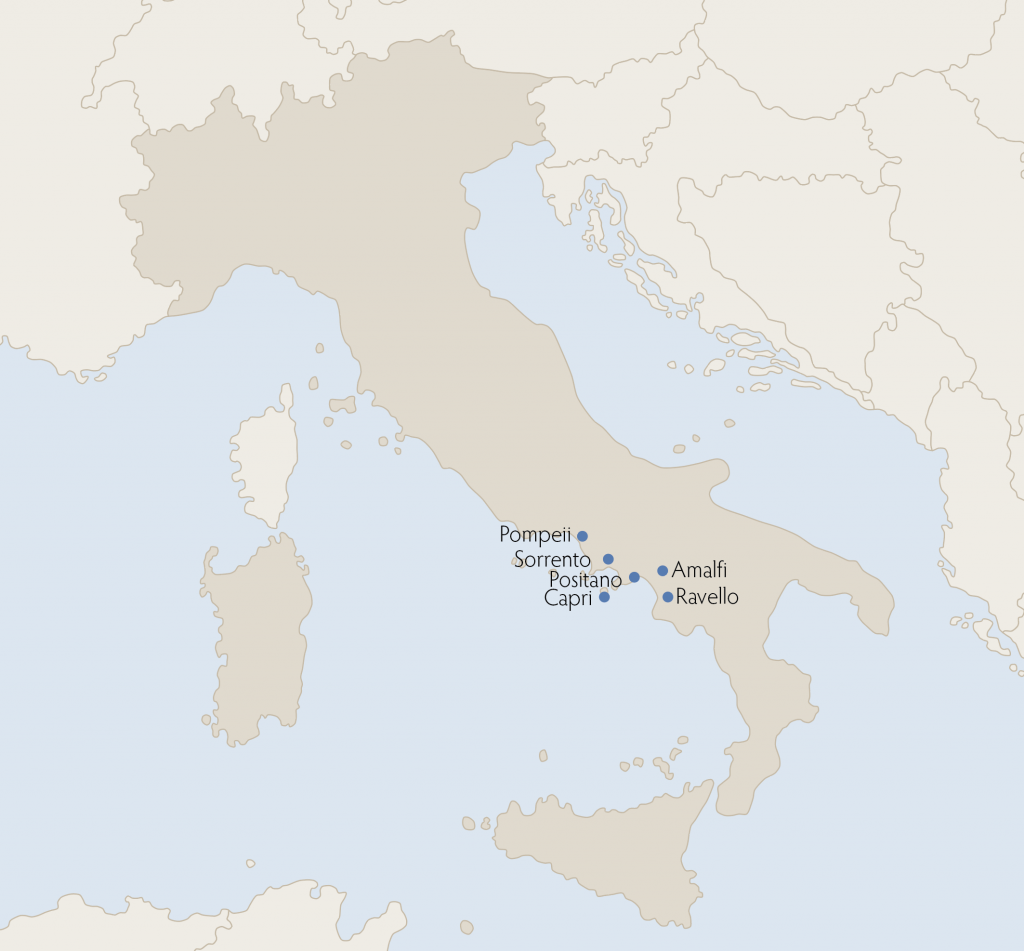
Some of the main towns of the Amalfi Coast
Positano
Perhaps the most famous town along the Amalfi Coast. Positano bewitches visitors with its gorgeous setting. Its pastel-hued houses tumble down from the mountains to the pebbled shoreline of Marina Grande. Here you can find the majolica tiled dome of the 13th century church of Santa Maria Assunta – a visual centrepiece. The twisting streets and staircases leading through Positano are filled with colourful shops, beautiful hotels, villas, and restaurants. Flower decked staircases and lanes make for intriguing wanderings and numerous photo ops.
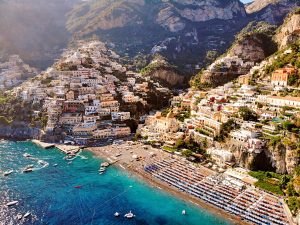
View of Positano
Rent a beach lounger, enjoy a drink or meal at one of the seaside restaurants or take an excursion by boat from the pier. They are all great ways to admire the beautiful surroundings from various vantage points. Positano’s past is revealed at MAR, the Roman Archaeological Museum, where you can see the frescoed remains of an excavated Roman Villa. Also worth a visit is the spectacular Path of the Gods trail. It is accessible from above the town, with stunning views over the sea and the coastal villages.
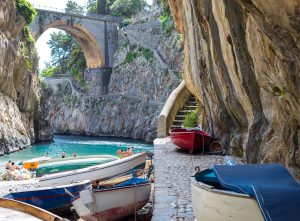
Fiordo di Furore beach in Positano
Amalfi
The city of Amalfi is scenically located at the mouth of a deep ravine that leads to the Mediterranean. It has a rich history, having been a powerful maritime republic along with Venice, Pisa, and Genoa from the 10th to 12th centuries AD.
Its picturesque core contains the spectacular Cathedral of Saint Andrew. It sits atop a steep flight of steps that lead up from the central Piazza del Duomo. En route you will find a warren of atmospheric alleys and streets to explore. The cathedral boasts Byzantine bronze doors and magnificent medieval mosaics. Wander up the streets into the steep hillsides through the Valle dei Mulini. Here you will see the remains of watermills that were used in Amalfi’s handmade paper-making industry. You can visit the Museum of Paper to learn more about this ancient craft.
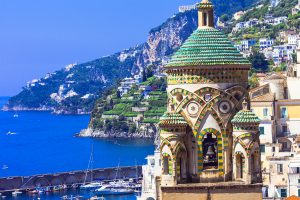
Beautiful views and beautiful churches in Amalfi
Amalfi’s historic trading relations with North Africa are captured in the Moorish architecture and beautiful courtyard of the Cloister of Paradise alongside the cathedral. Its Arsenal, a former medieval shipyard, harkens back to its illustrious past. The museum displays its former maritime prowess. Amalfi has its own beach at the Marina Grande area for relaxation and enjoying the sea and mountain views.
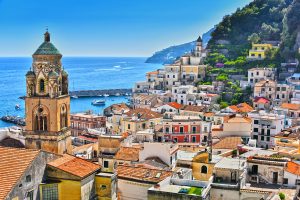
A view of Amalfi from above
Sorrento
Though not part of the Amalfi Coast, the beautiful northern city of Sorrento, is a great starting or ending point for any exploration of the Amalfi Coast. The city is renowned for its lemon groves, spectacular setting on cliffs overlooking the sea and its charming old town.
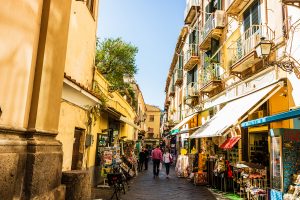
Walking on the narrow streets of Sorrento, Italy.
From the gardens of the Villa Communale, wonderful views overlook the Bay of Naples. Take a coffee, gelato or aperitivo while relaxing in the Piazza Tasso. It has many cafes with an atmospheric setting. Or you can also take a horse-drawn carriage ride. Wander through the picturesque lanes and streets of the old town. It is full of shops, boutiques, and restaurants. Be sure to visit the Marina Grande with its fishing village setting. You can take boat tours along the coast and enjoy swimming from one of its piers.
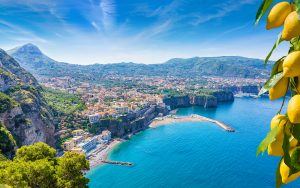
Sorrento’s coastline and Gulf of Naples, Italy
Sorrento also features the Correale Museum with its painting and decorative arts collections, the Cathedral of San Filippo, and the Cloisters of San Francesco. You can also venture just outside of town to swim in the natural pool at the site of a former Roman villa at the Baths of Queen Giovanna.
Ravello
Ravello has one of the most spectacular settings along the coast. Perched high up on the hillsides about 4km above Amalfi. From here, the views of the Mediterranean and the steep cliffs plunging into the sea are breathtaking. The main points of interest are the two beautiful villas, Villa Rufolo and Villa Cimbrone. Their gorgeous gardens and panoramas overlook the sea. Villa Rufolo was built in the 13th century and its stone watchtower, cloisters and garden setting inspired artistic luminaries. Richard Wagner wrote part of his opera Parsifal here. The famous Ravello Festival is held here every summer. The Villa Cimbrone is now an atmospheric hotel. Tts stunning gardens include the Infinity Terrace where the views seem to stretch on forever.
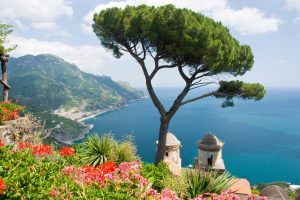
View from Ravello on the Amalfi Coast
Take time to enjoy the heart of this beautiful town. The 11th century Cathedral has impressive bronze doors on the elegant Piazza del Duomo, and wander its charming, cobbled streets. The town also boasts the Niemeyer Auditorium – a concrete and glass structure built by Brazilian architect Oscar Niemeyer. It is one of the most spectacularly sited performance venues in the world, perched over the sea.

